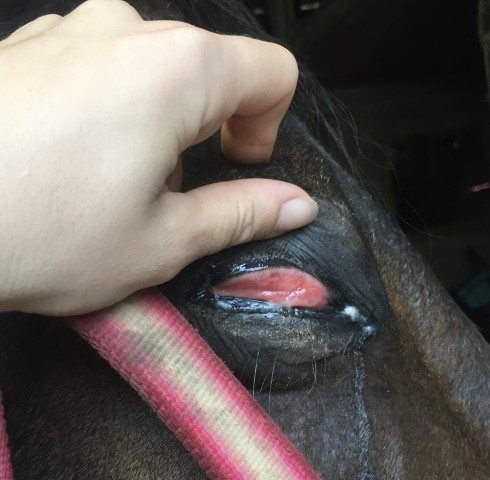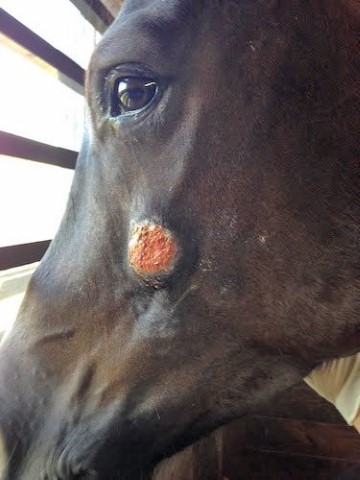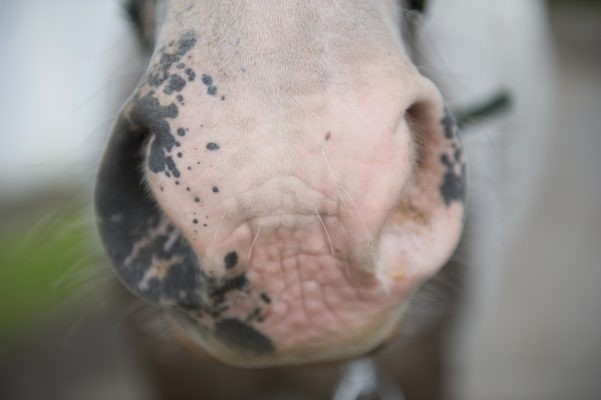With summertime sun and heat comes common seasonal-related issues in horses. Increased temperatures mean increased pests leading to a variety of problems. Heat stress-related disorders are also heightened during this time. Knowledge about prevention and treatment of common summer related conditions can be found by interacting with the hotspots in this month’s feature. For more information contact your local Extension agent or consult a veterinarian.
Image credit: Sarah Elder Chabot featuring Whatever She’s Havin

Conjunctivitis

Conjunctivitis, or pinkeye, flares up during the summer months in association with an increase in flies and airborne irritants. When an irritant such as a fly or dust affects the eye causing trauma the horse often rubs its leg to relieve the irritation allowing bacteria to enter the eye. Bacterial infection causes the eye to swell and the conjunctiva (the pink mucous membranes lining the eyelid) appear to ooze out of the eyelid, hence the name “pinkeye.” Conjunctivitis is easily treated using a topical antibiotic ointment and removal of the horse from the irritant. To prevent conjunctivitis, keep horses’ faces covered with a fly mask or in a protected environment when flies are active.
Summer Sores

Habronemiasis, commonly known as summer sores, is caused by stomachworm larva trapped in wounds and causing inflammation. If a house, face, or stable flies lays a stomach worm larvae in a wound, the larvae will not mature and stays in the wound causing irritation. Summer sores are characterized by their inability to heal and tendency to drain fluid. Any wound can develop into a summer sore, and they are commonly found in areas of the body such as the corners of the mouth and eyes that are consistently moist. The sores cause extreme itchiness and, if left untreated, will develop proud flesh. For mild sores, veterinarians recommend deworming with ivermectin or moxidectin to kill the larvae, topical treatment with anti-inflammatories, and keeping the area wrapped to protect and prevent itching. Additionally, fly control is critical to prevent potential deposition of larvae into wounds.
Information source: AAEP
Image credit: Spring Hill Equine
Anhidrosis

With rising summer temperatures, it is important that horses maintain the ability to cool themselves by sweating to prevent overheating. Anhidrosis is the decreased ability to sweat and is extremely dangerous. Horses with anhidrosis will usually begin producing minimal to no sweat when temperatures are consistently above 80°F. Symptoms include elevated respiration rate and an inability to produce adequate sweat. A horse with chronic anhidrosis will tend to lose hair on the forehead, drink less water, and become easily fatigued. No medical treatment has been proven to treat anhidrosis; however, it is important that horses afflicted with this syndrome have a reduced exercised program, be turned out during cooler times of the day with plenty of shade, and always have access to fresh, cool water.
Information source: University of Florida CVM
Image credit: Sarah Elder Chabot
Sunburn

During the summer months, the United States receives a greater amount of direct sunlight increasing the chances of sunburn. Sunburn is common on non-pigmented areas of the skin especially around the eyes and muzzle of bald-faced and light-colored horses. Typical signs of sunburn include skin lesions along with scaly, peeling skin. If left untreated, blisters can develop. Prolonged exposure to UV light can lead to cancer; thus, prevention and treatment is critical. During the summer months, turnout in the early morning, evening, or overnight is recommended. Application of equine sunscreen, fly spray containing sunscreen, or a full-face fly mask are also helpful to protect against UV rays.
Information source: AAEP
Image Credit: Horse and Hound